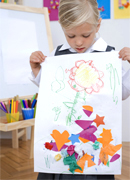Behaviour
Caring for babies
Bottle feeding
Changing a nappy
Cleaning and sterilising bottles
Daily cleaning tasks
Helping new children settle in
Preparing for a nappy change
Sleep patterns – babies
Sleep routines – babies
Toilet training
Caring for children
Allowing time for practice
Dressing/undressing
Mealtimes
Nappy change
Packing away/caring for the environment
Sleep/rest time
Toileting
Common self-help milestones
Tips for sleep and rest time
Self image
Communication
Body language
Limits and guidelines
Ways children communicate
Greeting children and families
Modelling appropriate communication
Questioning
Verbal and non–verbal communication
Acknowledging children's feelings
Listening attentively
Communicating with Aboriginal and Torres Strait Islander parents/carers
Development
Allowing time for practice
Dressing/undressing
Mealtimes
Nappy change
Packing away/caring for the environment
Sleep/rest time
Toileting
Common self-help milestones
Creative development
Language development
Modelling positive relationships
Physical development
Sharing and taking turns
Sleep patterns – babies
Sleep routines – babies
Encourage independent problem solving
Fundamental movement skills
Health, hygiene and safety
Coping with stress
Correct manual handling principles
Daily cleaning tasks
Hand washing
Hand washing poster
Manual handling overview
Toilet training
Safety checklist
Learning experiences and play
Environmentally friendly learning experiences
Learning experiences for different development areas
Creative resource materials
Arranging the environment to facilitate learning and pleasure
Indoors and outdoor areas
Creating a positive physical environment
Legal and ethical issues
Child abuse case studies
How do I recognise when a child or young person is at risk?
Tips on dealing with disclosures
Observation methods
Arranging Experiences (PDF 351Kb)
Recording observations
Rules for making observations
What you can learn from observations
Programming
Children’s interests, strengths, needs and skills
Extending the children’s interest in dinosaurs
Objective observation
Planning an OSHC environment
Behavior management plan
Planning enjoyable experiences
Planning experiences for 0 - 2 years age group
Planning experiences for 2 - 3 years age group
Planning experiences for 3 - 5 years age group
How a child expresses feelings
When you're feeling a certain way, how do you express your feelings? As adults, we have learned how to control our emotions and express them in appropriate ways. Children don't usually learn this skill until they have matured, so you often see a very raw demonstration of the way they are feeling - that is, their emotions are directly reflected in their behaviour. There are three main ways in which a child will express their feelings; through words, art and body language.
Words

Expressing yourself through words is a good place to start. By doing this, the person with whom you are communicating is in no doubt about what your feelings are. As a caregiver you need to be honest, and verbally expressing your feelings is a very appropriate way to do that.
As children are growing, their verbal communication skills gradually improve. Be aware that the words themselves only communicate part of the message. Pay close attention also to the tone of voice being used, and to the child's body language.
When communicating with children, make the language culturally and developmentally appropriate as well as using key words the child understands. Non-biased language should be used at all times.
Art
Art can be apparent in many forms - paint, paper, crayons, music, movement, and clay are just a few of these forms, and this is considered a meaningful way to express oneself. Have you ever used painting or poetry as a form of self expression? As a caregiver, you should always provide your children with a variety of means for self expression through art.
Some children will choose art to express their feelings, instead of talking about it. You need to pay close attention to the child's artwork for any messages they might be trying to communicate.

For example, Emily tends to use a lot of very dark colours and bold figures when she is painting - unlike the child in this picture who painted happy flowers in bright colours. Emily also paints with a very aggressive hand, often slamming the brush on to the paper with some force. This could be a sign that Emily is trying to express feelings such as anger or sadness, through her artwork.
Body language
Body language is a non-verbal language that is universally recognised. Your facial expressions and/or body stance can often give your true feelings away. Has this ever happened to you - your words are saying one thing, but your body is communicating something different?

Always look for signs of how a child is feeling through the body language they demonstrate, especially with those children who cannot speak yet. For example, Emily often demonstrates very negative body language such as folding her arms or standing with her back to people when they try to talk to her. She also uses her facial expressions to intimidate other children and turn them away if they try to approach her.
As a caregiver you will need to display non-verbal language appropriately. As with words, you can use your body language to show concern when needed or to share joy where appropriate.